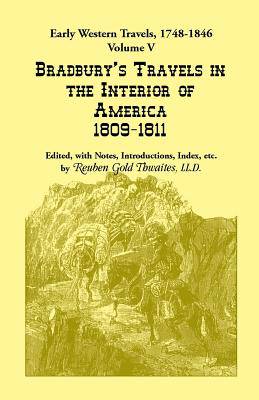
- Afhalen na 1 uur in een winkel met voorraad
- Gratis thuislevering in België vanaf € 30
- Ruim aanbod met 7 miljoen producten
- Afhalen na 1 uur in een winkel met voorraad
- Gratis thuislevering in België vanaf € 30
- Ruim aanbod met 7 miljoen producten
Zoeken
Early Western Travels, 1748-1846
Volume V: Bradbury's Travels in the Interior of America, 1809-1811. Edited, with Notes, Introductions, Index, etc.
Reuben Gold Thwaites
Paperback | Engels
€ 25,45
+ 50 punten
Uitvoering
Omschrijving
If stories of westward exploration stir up your imagination, you will enjoy these accounts of the travels of naturalist John Bradbury and others. Bradbury traveled from St. Louis to the Arikara Indian villages, some eighteen hundred miles above the mouth of the Missouri. From there he accompanied Ramsay Crooks to the fur-trading station among the Mandan, two hundred miles farther up river. His observations and experiences among the Native American tribes (both friendly and otherwise) are colorful and informative, as are his wondrous descriptions of rivers and natural features, settlements, fortifications, Canadian boatmen, war parties, narrow escapes from wild animals, buffalo herds and the buffalo hunt, fossil bones, a medicine man, a tremendous thunder storm, and much more, including an amazing recounting of the massive New Madrid earthquake. Although Lewis and Clark had returned from their expedition in 1806, their journals were yet to be published when Bradbury set out from St. Louis. At that time, any reports or illustrations of the people, wildlife and territory of the western United States were eagerly consumed by the public and the scientific community alike. Due to the technological limitations of the day, Bradbury's journals would not be published until 1817. Appendices include: a glossary of common words in the Osage language; an oration delivered by Big Elk (chief of the Maha nation) over the grave of Black Buffalo (chief of the Tetons); the narrative of the expedition of Mr. Hunt; Mr. Crook's narrative of Mr. Hunt's expedition from the Arikaras to the Pacific; a description of the Missouri Territory; remarks on emigration to the states of Ohio, Kentucky and Indiana, and the Illinois and Western Territories; and a catalogue of some of the more rare or valuable plants discovered in the neighborhood of St. Louis and on the Missouri. An important component of the collective history of western exploration.
Specificaties
Betrokkenen
- Auteur(s):
- Uitgeverij:
Inhoud
- Aantal bladzijden:
- 322
- Taal:
- Engels
Eigenschappen
- Productcode (EAN):
- 9780788414688
- Verschijningsdatum:
- 1/02/2013
- Uitvoering:
- Paperback
- Formaat:
- Trade paperback (VS)
- Afmetingen:
- 140 mm x 216 mm
- Gewicht:
- 371 g

Alleen bij Standaard Boekhandel
+ 50 punten op je klantenkaart van Standaard Boekhandel
Beoordelingen
We publiceren alleen reviews die voldoen aan de voorwaarden voor reviews. Bekijk onze voorwaarden voor reviews.








